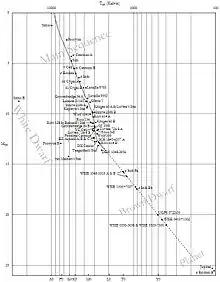WISE 0535−7500
WISE J053516.80−750024.9 (designation abbreviated to WISE 0535−7500) is either a sub-brown dwarf or a free planet. It has spectral class ≥Y1 and is [1] located in constellation Mensa. It is estimated to be 47 light-years from Earth.[2]
| Observation data Epoch J2000[1] Equinox J2000[1] | |
|---|---|
| Constellation | Mensa |
| Right ascension | 05h 35m 16.8s[1] |
| Declination | −75° 00′ 24.9″[1] |
| Characteristics | |
| Spectral type | ≥Y1[1] |
| Apparent magnitude (J (MKO-NIR filter system)) | >21.1[1] |
| Apparent magnitude (H (MKO-NIR filter system)) | >21.6[1] |
| Astrometry | |
| Proper motion (μ) | RA: −127±4[2] mas/yr Dec.: 13±4[2] mas/yr |
| Parallax (π) | 70 ± 5 mas[2] |
| Distance | 47 ± 3 ly (14 ± 1 pc) |
| Details | |
| Mass | 8 - 20[2] MJup |
| Age | 3 - 8[2] Gyr |
| Other designations | |
| Database references | |
| SIMBAD | data |

In 2017, more accurate analysis found it to be a binary system made up of two substellar objects of spectral class≥Y1 in orbit less than one astronomical unit from each other.[2]
Discovery
WISE 0535−7500 was discovered in 2012 by J. Davy Kirkpatrick et al. from data, collected by Wide-field Infrared Survey Explorer (WISE) Earth-orbiting satellite — NASA infrared-wavelength 40-centimetre (16 in) space telescope, which mission lasted from December 2009 to February 2011. In 2012 Kirkpatrick et al. published a paper in The Astrophysical Journal, where they presented the discovery of seven new found by WISE brown dwarfs of spectral type Y, among which also was WISE 0535−7500.[1]
Distance
Trigonometric parallax of WISE 0535−7500 is 0.070 ± 0.005 arcsec, corresponding to a distance of 14 pc and 47 ly.[2]
Y dwarf
Brown dwarfs are defined as substellar objects that have at some time in their lives burnt deuterium in their interior. The borderline between a brown dwarf and a planet is conventionally taken to be 13 times the mass of Jupiter. All brown dwarfs are either M dwarfs, L dwarfs, T dwarfs or Y dwarfs, in order of decreasing temperature. An increasing number after the letter in the spectral type also means decreasing temperature, a Y2 dwarf is cooler than a Y1 dwarf is cooler than a Y0 dwarf. Planets can also be L dwarfs, T dwarfs or Y dwarfs.[3]
References
- Kirkpatrick, J. Davy; et al. (2012). "Further Defining Spectral Type "Y" and Exploring the Low-mass End of the Field Brown Dwarf Mass Function". The Astrophysical Journal. 753 (2). 156. arXiv:1205.2122. Bibcode:2012ApJ...753..156K. doi:10.1088/0004-637X/753/2/156. S2CID 119279752.
- Leggett, S. K.; et al. (2017). "The Y-type Brown Dwarfs: Estimates of Mass and Age from New Astrometry, Homogenized Photometry, and Near-infrared Spectroscopy". The Astrophysical Journal. 842 (2). 118. arXiv:1704.03573. Bibcode:2017ApJ...842..118L. doi:10.3847/1538-4357/aa6fb5. S2CID 119249195.
- I. Neill Reid and Stanimir A. Metchev, Chapter 5: The Brown Dwarf – Exoplanet Connection, in John W. Mason (ed.) Exoplanets: Detection, Formation, Properties, Habitability; Springer, Berlin, 2008.